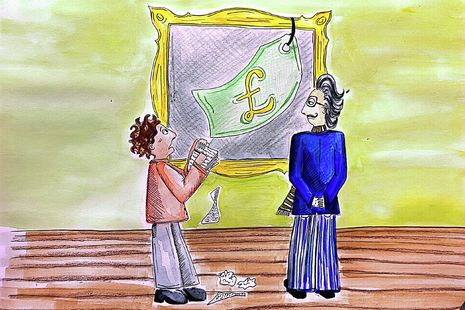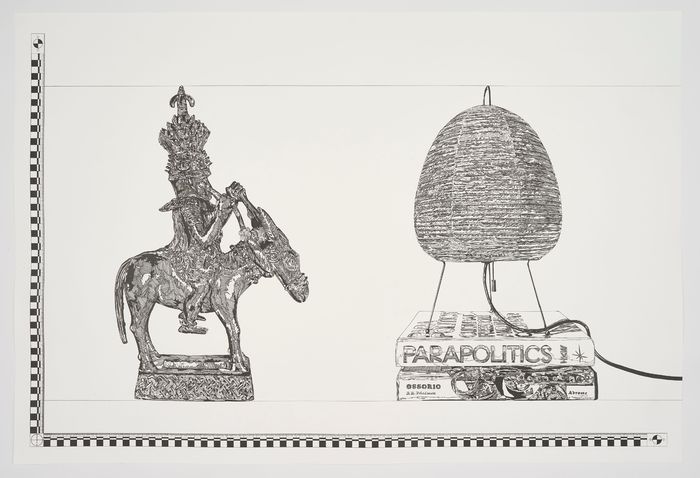How to guess the price of art
Ever wanted to look clever in a gallery? Here’s Colette Grice‘s guide to putting a figure to your favourite pieces of art

We are all used to seeing artworks across the globe go for more money than seems sensible. Whether it’s Basquiat’s Untitled series going for $46.5 million or Picasso’s ‘Femme à la montre’ selling for $139.4 million, many of us have witnessed extortionate market prices for pieces created on canvas and beyond. But what if you could actually predict how much a work of art could go for? Of course, you would be giving an estimate. But, with the knowledge that around 90% of the time, the million pound price mark is not even close to the majority of art price tags, you might just be able to flex the ability to guess how much a piece is worth and how well it would perform in your imaginary Sotheby’s auction room.
The odd thing about the art market is even the connoisseurs will overestimate, over-inflate the pricing points. Especially for those of us who aren’t continually walking around gallery fairs, or independent auction houses, it can seem like art only goes to those with very big wallets. But it’s not true. Even a brief look at an online auction space such as Artnet or Artsy would demonstrate to anyone that incredible art can go for less than £500, and, sometimes, less than £100.
“An artwork’s price is dependent on what is happening in the art world and the wider world at present”
The experts would lead you to believe that figuring out how much you should value a piece of art is a complex intersection of hundreds of factors that you could never know all at once. In some ways, they aren’t wrong; considerations around a work’s price are dependent on what is happening in the art world and the wider world at present. However, there are certain key factors which will always be the same when considering an artwork’s price, no matter what is going on elsewhere externally. If you’re able to analyse, or just get a vague sense, of these key points you might just be able to guess how much that artwork in your favourite gallery is worth. So, how do you do it?
Firstly, know your costs. Every piece of art has had a baseline requirement of tools to create it. Whether it’s oil pastels, carving tools, multiple canvases, or metalworks, money has gone into pulling that beautiful, intriguing design out of thin air and placing it into the real world for you to connect with and enjoy. Depending on your artist and their creative preferences, they could have spent anything from £50 to £500. It’s a good idea to consider the medium you’re looking at too; if it’s a painting, chances are they didn’t need to spend too much money. But, if it’s a life-size bronze sculpture, it’s going to be on the expensive end. Metalwork, for example, is definitely one of the most expensive mediums as the tools can sometimes be more costly than the materials.
“Scarcity always increases desirability and value”
Second, perhaps unsurprisingly, is size. No matter the medium, the rule is simple: the bigger the piece, the more time it took, the more it’s likely to be worth.
These two points are your basic framework, but here’s where it can get a little more complicated. An artwork, whether you personally believe it to be or not, is inextricably linked to the artist when it comes to what it will be worth on the art market. This means that if they’re incredibly well-known, they are very likely to be very expensive (enter our Basquiats and Picassos). There are just some artists whom everyone seems to know; in the art world they are referred to as a ‘Blue-Chip’ artist. When people come to buy or even sell art, they know that these artists’ pieces are always going to do well, and potentially fetch that million-dollar price if they’re really famous. Therefore, it’s good to remember that, for many, art is a long-term investment that could have huge financial returns, and thus incredibly sought after. As well as this, the sad but true fact is that if the artist isn’t around anymore, their art will be worth more: scarcity always increases desirability and value.
“Emotional value filters through art in many ways”
The final thing to consider goes beyond money, reputation, and tools: emotional value. Where and how you have found your piece of art influences this a little, but ultimately this one is almost entirely down to you. Say you find a piece in someone’s home, and you ask them how they came across it. They, in turn, give you a long story about this little art store they found on their honeymoon. They hint at the price, and it’s likely they overpaid for it from what you’ve already figured out, but to them the emotional significance for them justified the price. Emotional value filters through art in many ways, how are people drawn to it? Is there cultural significance? Was it owned previously by someone who is particularly notable? Is it reflecting something personal for the owner? Or is it simply striking to look at? These are some of the defining parts of what could make a piece sell for thousands.
Art is about perspective. In fact, the majority of art goes for around £5,000 to £10,000 — much less than a lot of us would predict. Because the purchasing of a piece, especially if it’s to end up above your fireplace, is such a personal decision, many of these ‘financial transactions’ don’t make it to the news. Because they didn’t go for millions, even if the sale of that piece was really important to the buyer. For artists, to sell even one piece is an incredible achievement — often the price it went for is insignificant. Art is to be enjoyed, exchanged, and seen in as many ways as possible. A lot can be said for the elitism of the art world, but one point that can always be disputed is its price.
 News / CUP announces funding scheme for under-represented academics19 December 2025
News / CUP announces funding scheme for under-represented academics19 December 2025 News / SU reluctantly registers controversial women’s soc18 December 2025
News / SU reluctantly registers controversial women’s soc18 December 2025 News / Cambridge welcomes UK rejoining the Erasmus scheme20 December 2025
News / Cambridge welcomes UK rejoining the Erasmus scheme20 December 2025 Features / Should I stay or should I go? Cambridge students and alumni reflect on how their memories stay with them15 December 2025
Features / Should I stay or should I go? Cambridge students and alumni reflect on how their memories stay with them15 December 2025 Film & TV / Timothée Chalamet and the era-fication of film marketing21 December 2025
Film & TV / Timothée Chalamet and the era-fication of film marketing21 December 2025










